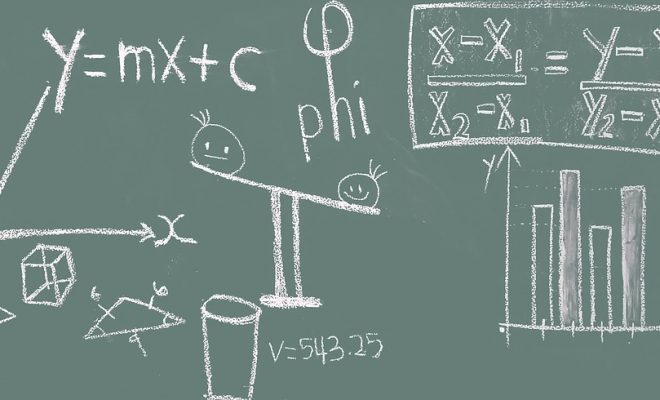Math Interventions That You Can Use in Your Classroom Today

Are you looking for math interventions for your students? If so, we have you covered. In this article, we will discuss, in detail, math interventions that you can use in your classroom today.
Math Computation: Encourage Math Learners to Draw to Clarify Understanding
Making a drawing of a word problem is one easy heuristic tool that learners can use to help them find the solution. A benefit of the drawing tactic is that it can reveal to the instructor any learner misunderstandings about solving the word problem. The instructor hands out a worksheet containing at least six-word problems to introduce learners to the drawing strategy. The instructor explains to learners that making a picture of a word problem sometimes makes that problem clearer and easier to solve. The instructor and learners then independently create drawings of each of the problems on the worksheet. Next, the learners show their drawings for each problem, explaining each drawing and its relation to the word problem. The instructor also participates, explaining his or her drawings to the class or group. Then learners are directed independently to make drawings as an intermediate problem-solving step when they are faced with challenging word problems.
Math Computation: Improving Performance in Math Through a 4-Step Problem-Solving Approach
Learners can perform better on applied math problems if they use an efficient 4-step plan that includes understanding the problem, devising a plan, carrying out the plan, and looking back. (1) Understand the Problem. To fully grasp the problem, the learner may restate the problem in his or her words, note key information, and find missing info. (2) Devise a Plan. In mapping out a tactic to solve the problem, the learner may make a table or translate the verbal problem into an equation. (3) Carry Out the Plan. The learner implements the steps in the plan, showing work and checking work for each step. (4) Look Back. The learner checks the results. If the answer is presented as an equation, the learner puts the results in words and ensures that the answer addresses the question posed in the word problem.
Math Computation: Boost Fluency Through Explicit Time-Drills
Explicit time drills are a method to boost learners’ rate of responding on math-fact worksheets. The instructor hands out the worksheet. Learners are told that they will have 3 minutes to work on problems on the sheet. The instructor starts the stopwatch and tells the learners to start work. After the first minute in the 3- minute span, the instructor’ calls time’, stops the stopwatch, and tells the learners to underline the last number written and to put their pencils in the air. Then learners are told to resume work, and the instructor restarts the stopwatch. This process is repeated after minutes 2 and 3. After the 3 minutes, the instructor collects the learner worksheets. Explicit time drills work best on math facts requiring a small number of steps. They are less effective on more complex math facts. Also, a less flexible version of this intervention is to use time-prompts while learners are working on math facts to quicken their response rate. At the end of each minute of seatwork, the instructor can call the time and have learners draw a line under the item that they are working on when that minute expires.
Math Computation: Motivate With ‘Errorless Learning’ Worksheets
Reluctant learners can be motivated to practice math number problems to build computational fluency when given worksheets that include an answer key displayed at the top of the page. In this incarnation of an ‘errorless learning’ approach, the learner is directed to complete math facts as quickly as possible. If the learner comes to a number problem that they cannot solve, the learner is encouraged to find the problem and its correct answer in the key at the top of the page and write it in. Such speed drills build computational fluency and prompt learners’ ability to visualize and use a mental number line. Consider turning this task into a ‘speed drill.’ The learner is given a kitchen timer and instructed to set the timer for each drill’s predetermined period. The learner completes as many problems as possible before the timer rings. The learner then graphs the number of problems computed each day on a time-series graph, attempting to better their last score.
Math Computation: How to Activate Academic Responding
Research shows that when instructors use specific techniques to motivate their classes to engage in higher active and accurate academic responses, learner learning rates will go up. Here are two ideas to obtain an increased academic response on math tasks. First, break longer assignments into shorter tasks with performance feedback given after each shorter ‘chunk.’ Breaking longer assignments into smaller segments also allows the instructor to praise struggling learners for work completion and effort, providing an additional ‘natural’ reinforcer. Next, let learners respond to easier practice items orally rather than in written form to speed up the rate of correct responses.
Math Homework: Motivate Learners Through Reinforcers, Interesting Assignments, Homework Planners, and Self-Monitoring
Improve learners’ homework completion rate and quality by using reinforcers, motivating ‘real-life’ assignments, a homework planner, and learner self-monitoring. (1) Reinforcers: Allow learners to earn a small reward (e.g., additional free time) when they turn in all homework assignments for the week. (2) ‘Real-life’ Assignments: Make homework meaningful by connecting concepts being taught to learners’ lives. In a math lesson on estimating areas, give learners the homework assignment of calculating the area of their bedroom or another part of their hours and estimating the amount of paint needed to cover the walls. (3) Homework Planner: Teach learners to use a homework planner to jot down assignments, organize any materials needed for homework, transport homework safely back to school, and provide space for parents and instructors to communicate about homework through written school-home notes. (4) Learner Self-Monitoring: Direct learners to chart their homework completion each week. Have learners plot the number of assignments submitted on time in green, assignments not submitted in red, and assignments submitted late in yellow.
Math Instruction: Consolidate Learner Learning During Lecture Through the Peer-Guided Pause
During large-group math lectures, instructors can help learners retain more instructional content by incorporating brief Peer Guided Pause sessions into lectures. Learners are trained to work in pairs. During one or more appropriate review points in a lecture period, the instructor directs learners to pair up to work for 4 minutes. During each Peer Guided Pause, learners are given a worksheet with one or more completed word or number problems demonstrating the math concept(s) covered in the lecture. The sheet also has additional, similar problems that pairs of learners work cooperatively to complete, along with an answer key. Learner pairs are reminded to (a) monitor their understanding of the lesson concepts, (b) review the correct math model problem, (c) work cooperatively on the additional problems, and (d) check their answers. The instructor can direct learner pairs to write their names on the practice sheets and collect them as a convenient way to monitor learner understanding.
Math Instruction: Increase Learner Engagement and Improve Group Behaviors With Response Cards
Response cards can increase active learner engagement in group math activities while reducing disruptive behavior. In the group-response technique, all learners in the classroom are supplied with an erasable tablet, such as a chalk slate or laminated board with an erasable marker. The instructor instructs at a fast pace. The instructor begins by posing a question to the class. Learners are given sufficient wait time for each to write a response on his or her response card. The instructor then directs learners to present their cards. If the majority of the class has the correct answer, the instructor praises the group. If more than one-quarter of the learners record an incorrect answer on their cards, the instructor uses guided questions and demonstrations to steer learners to the right answer choice.
Math Instruction: Maintain a Supportive Atmosphere for Classroom “Math Talk”
Instructors can promote greater learner ‘risk-taking’ in mathematics learning when cultivating a positive classroom atmosphere for math discussions while preventing peers from ridiculing each other. The instructor models behavioral expectations for open, interactive discussions, praises learners for their class participation and creative attempts at problem-solving and points out that incorrect answers and misunderstandings should be celebrated—as they often lead to breakthroughs in learning. The instructor uses open-ended comments (e.g., “What led you to that answer?”) as tools to draw out learners and encourage them to explore and apply math concepts in group discussion. Learners are also encouraged in a supportive manner to evaluate each other’s reasoning. However, the instructor intervenes immediately to prevent negative learner comments or ‘put-downs’ about peers. As with any negative classroom behavior, a first offense requires that the learner meet privately with the instructor to discuss instructor expectations for positive classroom behavior. If the learner continues to put down peers, the instructor imposes appropriate disciplinary consequences.
Math Instruction: Support Learners Through a Wrap-Around Instruction Plan
When instructors instruct learners in more complex math cognitive strategies, they must support struggling learners with a ‘wrap-around instructional plan. That plan implements several elements: (a) Assessment of the learner’s problem-solving skills. The instructor first verifies that the learner has the necessary academic competencies to learn high-level math content and reading/writing skills, knowledge of math operations, and grasp of required math vocabulary. (b) Explicit instruction. The instructor presents new math content in structured, highly organized lessons. The instructor also uses instructional tools such as Guided Practice and ‘overlearning.’ (c) Process modeling. The instructor adopts a ‘think aloud’ approach, or process modeling, to reveal their cognitive process to the class while using a cognitive tactic to solve a math problem. In turn, learners are encouraged to think aloud when applying the same tactic—first as part of a whole class or group, then independently. The instructor observes learners during process modeling to verify that they are correctly applying the cognitive strategy. (d) Performance feedback. Learners get performance feedback about their level of mastery in learning the cognitive tactic. That feedback can take several forms, including curriculum-based measurement, timely corrective feedback, specific praise and encouragement, grades, and brief instructor conferences. (e) Review of mastered skills or material. Once the learner has mastered a cognitive strategy, the instructor structures future class lessons or independent work to give the learner periodic opportunities to use and maintain the strategy. The instructor also provides occasional brief’ booster sessions’, reteaching steps of the cognitive strategy to improve learner retention.
Math Instruction: Unlock the Thoughts of Reluctant Learners Through Class Journaling
Learners can effectively clarify their knowledge of math concepts and problem-solving strategies through regular use of class’ math journals’. Journaling is an essential communication channel about math issues for learners who are unsure of their abilities and reluctant to contribute orally in class. At the start of the year, the instructor introduces the journaling assignment, telling learners that they will be asked to write weekly to instructor-posed questions. At first, the instructor presents ‘safe’ questions that tap into the learners’ opinions and attitudes about mathematics. As learners become comfortable with the journaling activity, the instructor starts to pose questions about the learners’ mathematical thinking relating to specific assignments. Learners are encouraged to use numerals, mathematical symbols, and diagrams in their journal entries to enhance their explanations. The instructor provides brief written comments on individual learner entries and oral feedback and to the class on the equality and content of class journal responses. Math journaling can prod learners to move beyond ‘rote’ mastery of the steps for completing math problems toward a grasp of the math concepts that underlie and explain a particular problem-solving approach. Instructors will find that journal entries are a concrete method for monitoring learner understanding of abstract math concepts. To facilitate the quality of journal entries, the instructor might also assign them an effort grade that will be calculated into math report card grades.
Math Problem-Solving: Help Learners Avoid Errors With the ‘Individualized Self-Correction Checklist’
Learners can improve their accuracy on types of word and number problems by using an ‘individualized self-instruction checklist’ that tells them to pay attention to their specific error patterns. To create such a checklist, the instructor meets with the learner. Together they analyze error patterns that the learner tends to commit on a particular problem type. For each type of error identified, the learner and instructor describe the appropriate step to prevent the error from occurring. These self-check items are collected into a single checklist. Learners are then encouraged to use their individualized self-instruction checklist whenever they work independently on their number or word problems. As older learners become proficient in creating and using these individualized error checklists, they can begin to analyze their math errors and make their checklists independently whenever they encounter new problem types.
Math Review: Balance Massed & Distributed Practice
Instructors can best promote learners’ acquisition and fluency in a newly taught math skill by transitioning from massed to distributed practice. When learners have recently acquired a math skill but are not yet fluent in its use, they need several chances to try out the skill under instructor supervision—a technique sometimes referred to as ‘massed practice. Once learners have developed facility with that new math skill, they must be required to use the skill to retain it; a tactic also known as ‘distributed practice.’ Instructors can program distributed practice of a math skill such as reducing fractions to least common denominators into the curriculum either by (a) regularly requiring the learner to complete short assignments in which they practice that skill in isolation or (b) teaching an advanced algorithm or problem-solving approach that incorporates, and requires repeated use of the previously learned math skill.
Math Review: Teach Effective Test-Preparation Strategies
A juxtaposition of the methods that high and low-achieving math learners typically use to prepare for tests suggests that struggling math learners need to be taught (1) specific test-review strategies and (2) time-management and self-advocacy skills. Among these strategies, deficient test-takers benefit from explicit instruction in taking adequate notes, adopting a method to review material for tests, and giving themselves additional practice in solving problems. Struggling test-takers also require pointers to manage their study time wisely, structure their study environment to increase concentration, and develop ‘self-advocacy skills such as seeking help from instructors when needed. Instructors can teach effective test prep methods as a whole-group instructional strategy.
Math Vocabulary: Pre-teach, Model, and Use Standard Math Terms
Three strategies can help learners learn essential math vocabulary: pre-teaching vocabulary items, modeling those vocabulary words and using universally accepted math terms in instruction. (1) Preteac math vocabulary. Math vocabulary provides learners with the language tools to grasp abstract mathematical concepts and to explain their reasoning. Preview math vocabulary as a regular part of the ‘background’ information that learners receive in preparation to learn math concepts or operations. (2) Model the vocabulary when new concepts are taught. Strengthen learners’ grasp of vocabulary by reviewing several math problems with the class, each time explicitly modeling the use of appropriate vocabulary to describe the concepts being taught. Then have learners engage in cooperative learning or individual practice activities in which they too must successfully use the new vocabulary—while the instructor provides targeted support to learners as needed. (3) Ensure that learners learn standard, accepted labels for common math terms and that they use them to describe their math problem-solving efforts





